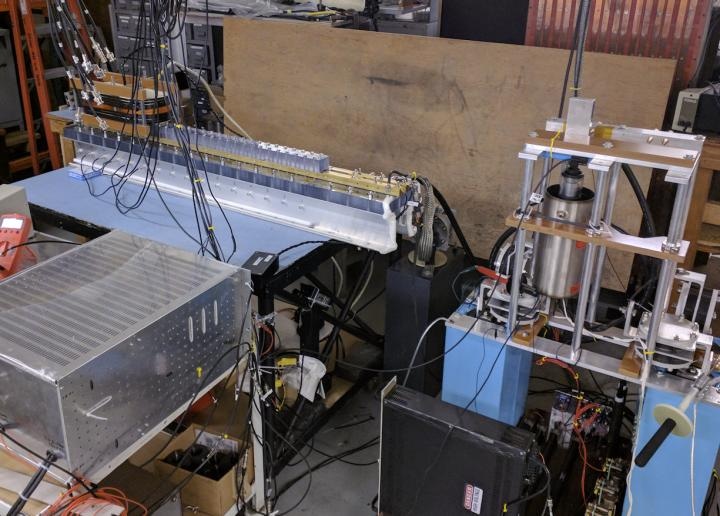Jan 25 2019
Researchers who seek to capture and control the fusion energy—the process powering the stars and the sun—on Earth are faced with the risk of disruptions, that is, unexpected events that can interrupt fusion reactions and cause damage to the facilities known as tokamaks in which they are housed.
 Prototype of EPI at center-left of image. (Image credit: Roger Raman)
Prototype of EPI at center-left of image. (Image credit: Roger Raman)
An innovative prototype for quickly controlling disruptions before they can completely affect the process has been developed by scientists at the U.S. Department of Energy’s (DOE) Princeton Plasma Physics Laboratory (PPPL) and the University of Washington.
Named “electromagnetic particle injector” (EPI), the device is a kind of railgun from which a high-velocity projectile is fired from a pair of electrified rails into a plasma on the brink of disruption. The projectile is known as a “sabot” and discharges a payload of material into the center of the plasma, radiating (or spreading out) the energy stored in the plasma, thus minimizing its effect on the interior of the tokamak.
Deeply Penetrating Payloads
This technique might emerge as a faster process that may enable payloads to penetrate more deeply into the plasma than most advanced techniques existing at present. Although the existing systems discharge gas-propelled shattered pellets or pressurized gas into the plasma using a gas valve, the mass of the gas particles restricts the velocity.
The primary advantage of the EPI concept over gas-propelled systems is its potential to meet short-warning time scales.
Roger Raman, Physicist, University of Washington.
Raman is on a long-term assignment to PPPL and is the lead author of a paper published in Nuclear Fusion describing the new system.
The risk of disruptions is specifically higher for ITER, the large international tokamak that is being built in France to prove the feasibility of fusion power. The high-power, dense discharges of plasma, the state of matter fueling the fusion reactions, in the ITER will render it challenging for existing gas-propelled techniques of mitigation to penetrate sufficiently deep into the highly energetic ITER plasma to have a good effect.
On ITER, the time desired for the mitigation to occur is less than 20 ms, or thousands of a second, from the warning of a disruption, where 10 ms is considered to be ideal. Investigations of the EPI prototype reveal that it has the ability to offer a payload of aptly sized particles within 10 ms, in contrast to the 30 ms for gas-propelled systems.
The prototype, developed at the University of Washington, is similar to a fusion reactor fueling system on which Raman worked many years ago. In that system, plasmoids—or football-shaped plasmas that have their own magnetic fields—were injected at high velocity into a fusion plasma. In order to develop the EPI, Raman employed certain features of that system to enable considerably more mass to be injected in a less complex configuration, as would be needed for a long standby operation mode.
Electrically Conducting Rails
In the prototype, the sabot is housed between two electrically conducting rails positioned about 2–3 cm apart and coupled to a capacitor bank in which an electrical charge is held. When the bank is discharged, electromagnetic forces accelerating the sabot are produced, thereby facilitating the release of the payload within just 2 ms. The material, made of light-metal pellets or granules, would diffuse the energy of a disruption from the plasma’s center to its edge, thus scattering the energy and weakening its effect on the walls of the tokamak.
It has been proposed that further advancement of the EPI system will be performed at PPPL. The proposal requires the construction of second- and third-generation prototypes with progressively strong magnetic fields over a period of three years, and subsequent deployment on a tokamak in the fourth year. The outcomes to date, as described in Nuclear Fusion, assure that it is possible to develop an effective EPI system to mitigate strong disruptions on ITER.
Jonathan Menard and Masa Ono of PPPL and Wei-Siang Lay and Thomas Jarboe of the University of Washington have collaborated with Raman in this research publication. The DOE Office of Science has supported this study.
PPPL, on Princeton University’s Forrestal Campus in Plainsboro, New Jersey, is dedicated to developing innovative knowledge about the physics of plasmas—ultra-hot, charged gases—and to come up with practical solutions for producing of fusion energy. The Laboratory is managed by the University for the U.S. Department of Energy’s Office of Science—the largest single supporter of basic research in the physical sciences in the United States, which is striving to deal with some of the most critical challenges at present.